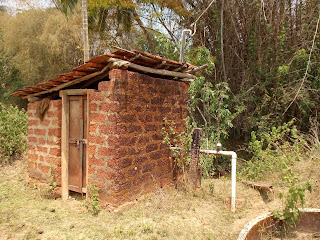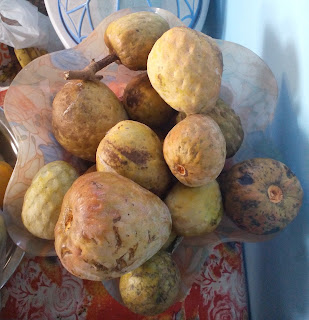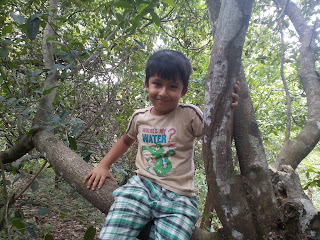I am
living in a village after deciding to move out of city and
buying the farm. Apart from being a farmer, I am still a software architect too. I spend almost half a day on software projects. Therefore I need reliable internet service. There are some challenges for internet service in a village. This post provides information about how I solved the problem. Please note - I don't have any affiliation to any brands I mention in this post. I am describing what I did to solve my problem hoping that will help someone with similar challenges.
BSNL is the only internet service provider who can connect a copper wire to homes when it comes to villages here. Catch is -
BSNL lines don't work for most of the time in a year because by the time their service department fixes the line it again goes bad; more so during monsoon. That is why many people in these villages are phasing out copper line phones in favor of cell phones. Therefore I decided not to take
BSNL copper line connection for internet.
Only option left after that decision was buying 3G/4G internet service. I studied signal strength of different service providers in the village. I used my cell phone for the signal strength study. My phone showed fairly strong 3G signal from
Airtel during the study (4G has not started yet, so only 3G for now though SIM is 4G). That is why I rented out the home in the village and moved in. I use a wifi router with 3G/4G USB dongle support (D-Link DWR-116 model). When I installed my 4G dongle (Huawei E-3276 model) with
Airtel 4G SIM it did not show any 3G/4G signal even on the roof top. I was disappointed with the situation because I had already moved into a beautiful home in the village, but no internet in that place :-(
Being an engineer by nature (and by training - I am a structural engineer), I was not going to give up so easily. Nearest 3G tower from the village is 6 kms away. There was no way tiny 2-3 cm long antenna in the dongle could transmit signal up to 6 kms of thick forest. I thought a good antenna setup will make it work. Some
research on internet showed I can use a
Yagi antenna.
Yagi antenna (actually it is called
Yagi Uda antenna because it is named after the inventors) is a directional antenna which is easy to design, fabricate and use. I was unable to use the designs from
whirlpool website because matching boom and element materials were not available here. I used
Yagi CAD and
MMANA-GAL software to design and optimize the antenna for the material I got. I designed a fabricated 2 antennas - one with 4 mm diameter solid copper elements and another one with 9 mm aluminium pipe elements. Here is one my antennas in action:
 |
| 4 mm copper wire element antenna |
3G band is essentially UMTS technology. According to
wikipedia page frequency range of UMTS 2100 band used in Asia is - 1920-1980 MHz for uplink and 2110-2170 MHz for downlink. Middle of frequency range is 2045 MHz. Antenna is designed for this middle frequency. In the absence of any more authentic information I took that as the design frequency for the antenna. Antenna element lengths should be accurate to fraction of a millimeter. I ended up buying a vernier caliper for the purpose of measuring the elements when cutting them.
 |
| 3G/4G USB dongle enclosed in a box |
My 3G/4G dongle (Huawei E-3276 model) has CRC-9 type connectors for connecting antenna. I bought 2 numbers of CRC-9 to F-female connector adapters on ebay to connect the antenna to the dongle. CRC-9 connectors on the dongle are delicate. I enclosed the dongle in a box and brought out the F(female) connectors to avoid any damage in daily usage. I connected the antenna to dongle using a piece of 75 Ohms
RG-6 cable (used for connecting DTH antenna to the set top box). I crimped a F connector to the end of the RG-6 wire connected to the dongle. This dongle uses only one antenna when connected to 3G. This dongle can boost the speed when connecting to 4G network using
MIMO technology. For using MIMO we need to use 2 antennas mounted at 45 degree angle to vertical direction.
 |
| Dongle connection details |
After connecting the antenna I got good internet speed. However, my happiness was short lived. After few minutes my dongle used to drop the connection and did not reconnect until I switched off the whole stuff and switched it on. What that means is power cycling was necessary to connect the dongle once it drops the connection. I struggled with it for quite some time. One day the bulb lighted - I thought probably dongle needs more power than the power provided by the USB port of the wifi router. More so because probably the dongle is trying to transmit stronger signals since it is working in a weak signal area. I scavenged a USB-female port from a USB hub. I soldered two separate USB cables (male part) to it - one for carrying the USB signals and another one exclusively for power. Instead of using power from the USB port of wifi router now I can power my dongle using a 5V 2A external power adapter. Bought a 5V 2A power adapter online and plugged it in. That solved connection drop problem all together!
Little bit more about the dongle connections: Two metal connectors you see in the picture above towards the left are CRC-9 connectors. Wires from those 2 connectors lead to the metal connectors on the lower side - which are two F(female) connectors for connecting
F connectors on the end of
RG-6 cable. Small piece of green circuit board towards the top is the board soldered to female USB port scavenged from a USB hub. That female USB port is plugged into the USB port of the dongle. There are two wires soldered to the circuit board. Thin wire is soldered to the data connectors of USB port. USB end of that wire goes into the USB port of the wifi router. Thick wire is soldered to the power connectors of the USB port. USB end of that wire goes to 5V 2A power adapter.
This is the speed measured now using
speedtest.net. Connection is stable now though speed varies quite a bit. Isn't that a big improvement from "no internet" without the antenna?
 |
| Internet speed after connecting antenna and external power supply |
You may ask what happens when
Airtel begins 4G service in the town? Nothing - 3G will continue to work as long as Airtel transmits 3G signals. I will get 4G if I design, fabricate and connect a 4G antenna (which I am planning to do when 4G service begins). That's all!
Update on 10-Jul-2016:
Huawei E-3276 dongle started acting unstable for last few days and finally stopped working. It does not show any error when connected to computer. It shows very weak signal and fails to connect to service provider. Now I guess it is because of high humidity in the air since it had been raining heavily in this area for last few days.
My work needs internet connection. There was no time to order some device online and wait for several days for the delivery. I know service provider (Airtel) sells internet connection device because my friend has one. I borrowed that one for testing. I had a "wow" moment when I connected to it. It shows almost full strength 3G signal and provides stable internet connection if I place the device in first floor at a height - without any external antenna! Immediately I ran to the town and bought the device. It turned out to be Huawei-E5573s-606. Now I am using this device without any antenna. Yagi antenna that served me well for last 2 years is having well deserved rest now :-)


















